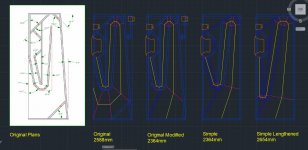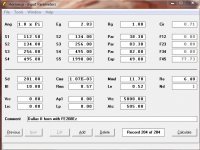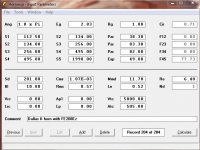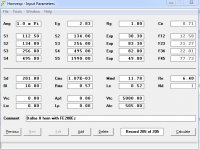I hope this is not sacriledge to suggest but.....
Has anyone looked at modifying the Dallas II to have downward firing exit I.e. open base. This seems to work well with the Tune Audio Prime which uses the FE168E Sigma plus at FT96H, so similar drivers to the Dallas II?
Tune Audio Prime Loudspeakers | Hi-Fi+
The basic idea is to board up the front firing port, modify the angle of the return section and then open up the base and add adjustable legs, area of the exit will be approx 450x280mm. Based on the centreline of the horn, the length will not be much different but may need lengthening maybe up to 200mm either by moving the driver up or lengthening the first leg of the horn.
Now, I know this is a well thought out design and you should not mess but just a thought?
Also, whilst I am on, does anyone have a plot of the horn cross section normal to its centreline they would care to post, my initial go at finding this suggest a parabolic or possibly exponential profile but would like confirmation.
Any ideas/views would be gratefully received.
Has anyone looked at modifying the Dallas II to have downward firing exit I.e. open base. This seems to work well with the Tune Audio Prime which uses the FE168E Sigma plus at FT96H, so similar drivers to the Dallas II?
Tune Audio Prime Loudspeakers | Hi-Fi+
The basic idea is to board up the front firing port, modify the angle of the return section and then open up the base and add adjustable legs, area of the exit will be approx 450x280mm. Based on the centreline of the horn, the length will not be much different but may need lengthening maybe up to 200mm either by moving the driver up or lengthening the first leg of the horn.
Now, I know this is a well thought out design and you should not mess but just a thought?
Also, whilst I am on, does anyone have a plot of the horn cross section normal to its centreline they would care to post, my initial go at finding this suggest a parabolic or possibly exponential profile but would like confirmation.
Any ideas/views would be gratefully received.
Managed to do a bit of scheming thing this evening. So attached is a quick mock up of the Dallas II from the plans on Frugalhorn.
From left to right they are -
1) The original plans
2) The original plans sketched up in Autocad with a rough line centreline length of 2588mm (note the drivers are the FE208E Sigma and FT96H plus I have added a carbuncle on the rear to house the LPad /Capacitor and speaker connection). The FE208 mod to the rear chamber has also been added.
3) This has the front extended to the floor and an additional piece added to make the base exiting port, otherwise it is as per the plans. Line length is shorter at 2364mm
4) This rotates the fold of the horn out to simplify the build but maintains the dimensions of the original,line length still 2364mm
5) This elongates the first leg out and simplifies the build even more therefore extending the line length nearer the original at 2654mm (probably over did it a bit so can be shortened), I have also compensated for the bends as they are further down the horn (widened them slightly).
So, I guess questions are - the most reliable to build is No3 - all as per plans but will the reduction in horn centreline length have much of an effect. otherwise, if No5 was edited to get the line length the same as the original are there any real issues with this.
From left to right they are -
1) The original plans
2) The original plans sketched up in Autocad with a rough line centreline length of 2588mm (note the drivers are the FE208E Sigma and FT96H plus I have added a carbuncle on the rear to house the LPad /Capacitor and speaker connection). The FE208 mod to the rear chamber has also been added.
3) This has the front extended to the floor and an additional piece added to make the base exiting port, otherwise it is as per the plans. Line length is shorter at 2364mm
4) This rotates the fold of the horn out to simplify the build but maintains the dimensions of the original,line length still 2364mm
5) This elongates the first leg out and simplifies the build even more therefore extending the line length nearer the original at 2654mm (probably over did it a bit so can be shortened), I have also compensated for the bends as they are further down the horn (widened them slightly).
So, I guess questions are - the most reliable to build is No3 - all as per plans but will the reduction in horn centreline length have much of an effect. otherwise, if No5 was edited to get the line length the same as the original are there any real issues with this.
Attachments
Sounds like a right mess. Ron Clarke designed the mouth section using fluid-dynamics software to blend the frequencies around 200-300Hz as well as possible with the front driver output. If you put the exit at the bottom you're going to have a bit physical separation that will likely leave a hole in the lower midrange. Also it's nearly always a bad idea to have frequencies above about 150Hz coming out too near the floor.
The Tune Audio speakers get pretty mixed press - some of it quite bad - in the areas I'm suggesting.
The Tune Audio speakers get pretty mixed press - some of it quite bad - in the areas I'm suggesting.
Actually I'm going to have to correct myself ( embarrassingly ) that there is quite a lot of bad press about the Animas - a couple of the items I was thinking about were actually about the Avatons, though I do have personal communication from a trusted listener about shortcomings specifically in the lower-mids of the floor-firing one.
But anyway I suppose the aim is to boost the low bass performance ?
I'd much rather leave it as it was designed/optimised and add a tapped horn for 30-70Hz approx.
I have read almost everything Ron Clarke wrote about that design. I have a friend in Yorkshire who has modelled the expansion in 3D in a CAD fluid dynamics software package himself, and you can see how the sloping upward mouth wall below the driver helps the wavefronts flow upwards and blend with the front output. You can watch it running at different frequencies, it's fascinating.
Just make sure you can go back to the standard design !
But anyway I suppose the aim is to boost the low bass performance ?
I'd much rather leave it as it was designed/optimised and add a tapped horn for 30-70Hz approx.
I have read almost everything Ron Clarke wrote about that design. I have a friend in Yorkshire who has modelled the expansion in 3D in a CAD fluid dynamics software package himself, and you can see how the sloping upward mouth wall below the driver helps the wavefronts flow upwards and blend with the front output. You can watch it running at different frequencies, it's fascinating.
Just make sure you can go back to the standard design !
Would you like a Hornresp model of the expansion ?Also, whilst I am on, does anyone have a plot of the horn cross section normal to its centreline they would care to post, my initial go at finding this suggest a parabolic or possibly exponential profile but would like confirmation.
Printout here -
It's more of a hyperbolic, with a very slow expansion at first , then a faster flare at the end. If you change the segment definitions to exponential ( it make very little difference, they are so slow ) you can see the expansions in Hz, it starts around 20Hz. I will post another picture with this.
Attachments
Last edited:
@IslandPink Many thanks for the info, much appreciated. Will have a good read later. I have a copy of Hornresp and also Leonardo TL so will have a go at replicating the model you have posted and see what happens.
Thanks again but as you said, may be best not to bother and live with the aesthetics of the original (not the prettiest speaker!), may have to make a 3D models and see if I can find a way of making it look reasonable.
Thanks again but as you said, may be best not to bother and live with the aesthetics of the original (not the prettiest speaker!), may have to make a 3D models and see if I can find a way of making it look reasonable.
If you keep building horn speakers for long enough, you should be able to come to terms with the aesthetics -
Something stirs in the Undergrowth - Page 148 - audio-talk
I have stashed a couple of word documents full of Ron Clarke postings over 15 years or so. Some from here, some from AA and some from FullRangeDriver forum ( in archive only ) . I think they are only on my work computer ( oops ! ) . If you PM me your email I can send them to you so you can get a better idea of how the standard design all works.
The length of the horn , the driver and baffle width, and the throat chamber all work together to define the acoustic crossover around 260Hz. The 208 on a 12.4" wide baffle drops off earlier than you see on the datasheet ( IEC baffle ) so the midrange is already on the downslope at 300Hz. So then you need the upper end of the horn output to come in perfectly to boost this and take over below 200Hz. At 260Hz, the horn length of ~2.65m is exactly 2 wavelengths, so the two outputs are in phase for a short region around crossover. The throat chamber is sized to create a low pass filter that starts pulling down the horn output from 200Hz, and steeply after 400Hz.
Something stirs in the Undergrowth - Page 148 - audio-talk
I have stashed a couple of word documents full of Ron Clarke postings over 15 years or so. Some from here, some from AA and some from FullRangeDriver forum ( in archive only ) . I think they are only on my work computer ( oops ! ) . If you PM me your email I can send them to you so you can get a better idea of how the standard design all works.
The length of the horn , the driver and baffle width, and the throat chamber all work together to define the acoustic crossover around 260Hz. The 208 on a 12.4" wide baffle drops off earlier than you see on the datasheet ( IEC baffle ) so the midrange is already on the downslope at 300Hz. So then you need the upper end of the horn output to come in perfectly to boost this and take over below 200Hz. At 260Hz, the horn length of ~2.65m is exactly 2 wavelengths, so the two outputs are in phase for a short region around crossover. The throat chamber is sized to create a low pass filter that starts pulling down the horn output from 200Hz, and steeply after 400Hz.
@fb2017, did you build them yourself and if so did you just use an angle adjustable bench saw to get those odd angles and how critical were they? Also are yours fe206 or fe208? Finally how do you like them and what are you driving them with (I am considering a Pass F5 to go with a Dallas II fe208 + FT96H version)?
@planet10, did a bit of googling and the suggestion is that the Fostex need between 20 and 50ohm output impedance from the amp to work best. Is this also your understanding or can I go a bit lower ?
looking at the Pass amps that seems to point to the F1J or am I reading the table on the Pass site wrong ?
FIRST WATT PRODUCTS
looking at the Pass amps that seems to point to the F1J or am I reading the table on the Pass site wrong ?
FIRST WATT PRODUCTS
I have built them pwith the help of a retired pipe organ builder. I have used the FE206En. Please search this forum for my posts, I have put some measurements and reviews. I'm very pleased with them, I was seldom left wanting something else from my system.
The angles are critical, so you need an angled bandsaw to successfully complete them. I drive them with an Edison 60 tube amp I soldered myself, and they are connected to the 8 ohm output. If you search my posts you'll find some thoughts on the amp as well.
All in all, I really doubt you can change anything in the geometry with good results without some very extensive research and simulations.
Where exactly have you found the suggestions that the Fostex should be driven at 20 or more ohm?
The angles are critical, so you need an angled bandsaw to successfully complete them. I drive them with an Edison 60 tube amp I soldered myself, and they are connected to the 8 ohm output. If you search my posts you'll find some thoughts on the amp as well.
All in all, I really doubt you can change anything in the geometry with good results without some very extensive research and simulations.
Where exactly have you found the suggestions that the Fostex should be driven at 20 or more ohm?
Last edited:
I would be extremely careful about altering Dallas II. While it was one of Ron's earlier load configurations, which he subsequently abandoned in favour of the Austins, it was extremely carefully designed; the physical dimensions and locations are functional. It was partly Ron that pushed me to look at refining form factors of my own designs in a similar way. He put a lot of attention into assessing structural loads, which is partly why the enclosure has the external shape it does, and the position of the terminus, baffle shape and size all affect the behaviour and pressure-wave / loading and the practical results. If you start shifting things about, you will alter these away from what was designed.
Just to understand how important the geometry of these designs is, check out these tunable bad boys here
Unique speakers - Router Forums
Unique speakers - Router Forums
Thanks all. As stated I will use the Dallas II in their standard form based on the comments provided, many thanks for steering me along the righteous path !
As for amp output impedance - Planet10 mentioned it above, also found it mentioned here -
Fostex, Sigma or not ? - Post #5
https://www.passdiy.com/pdf/cs-amps-speakers.pdf - talks about 16ohms on Son of Zen on Fe208's
Any direction on a low power solid state amp kit/diy build would be gratefully received. I was interested in the ACA (15w monoblocks) but can't find out the output impedance, will keep searching.
As for amp output impedance - Planet10 mentioned it above, also found it mentioned here -
Fostex, Sigma or not ? - Post #5
https://www.passdiy.com/pdf/cs-amps-speakers.pdf - talks about 16ohms on Son of Zen on Fe208's
Any direction on a low power solid state amp kit/diy build would be gratefully received. I was interested in the ACA (15w monoblocks) but can't find out the output impedance, will keep searching.
Last edited:
- Status
- This old topic is closed. If you want to reopen this topic, contact a moderator using the "Report Post" button.
- Home
- Loudspeakers
- Full Range
- Dallas II modification



